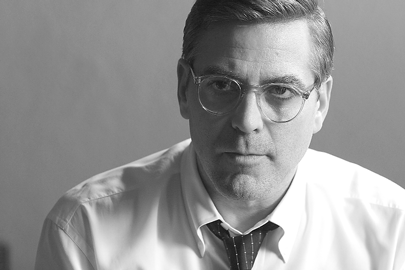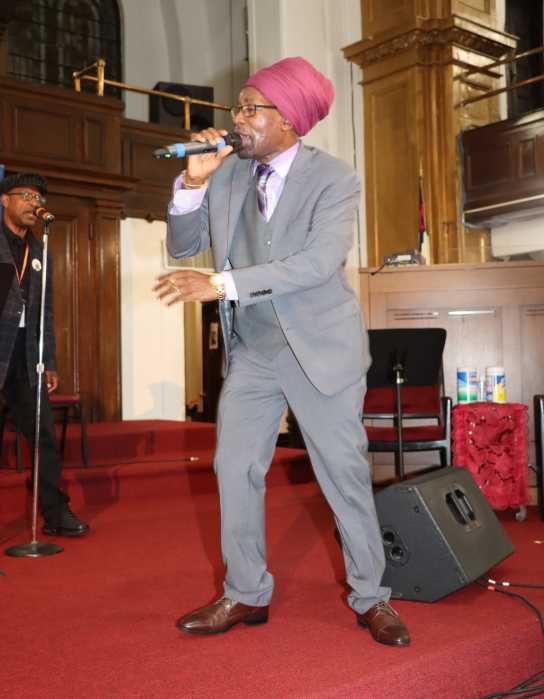Bold docudrama weighs journalistic fact against artistic license
“People want to enjoy themselves, not get a civics lesson.”
That’s what Bill Paley, head honcho at CBS, apprises newsman Edward R. Murrow toward the climax of “Good Night, and Good Luck,” the new docudrama directed, co-written, and starring George Clooney. It’s Paley’s excuse for relegating Murrow’s contentious news program, “See It Now,” to broadcast Siberia.
Though the film takes place in the mid-1950s, Paley’s admonition pretty much sums up the debate that still roils television boardrooms today—entertainment versus social responsibility—under an unblinking eye on ratings and the bottom line.
“It has always been a battle between corporate and information,” said Clooney at a recent press conference at a New York City hotel. “It’s a tricky one.”
Clooney, along with cast members David Strathairn, who plays Murrow, Grant Heslov, who co-wrote the script, and Patricia Clarkson were in town to talk up the courageous film, which opened the New York Film Festival to critical adulation.
This corporate battle, as waged by Murrow, intrigued Clooney so thoroughly that he simply had to capture it on film. The “most trusted man in America,” seen by over 40 million viewers each week in 1953, was a hero of sorts for Clooney and his father, who was a broadcast journalist himself.
“I grew up on a newsroom floor watching my dad piece a news show together,” explained Clooney. “Murrow was always the high water mark that everyone aimed for. It was my love of that, a tip of a hat to my dad and the sacrifices he made over the years.”
“There is a revisionist history going on that McCarthy was right and Murrow was a traitor,” Clooney continued. “It was important to recalibrate fact.”
No doubt Paley’s words haunted Clooney, who plays the role of “See it Now” producer Fred Friendly, as he shaped this convention-busting film. “Good Night, and Good Luck” painstakingly recreates a brief, shining moment in television history when the indefatigable Murrow brought down Senator Joseph McCarthy, the right-wing Republican loose cannon from Wisconsin who ruined lives by branding innocent citizens as Communists with no proof.
As Clooney struggled to portray the complexities of Murrow’s dicey decision to go after McCarthy on the airwaves, he was also balancing the need to get the facts straight with the desire to craft a compelling story moviegoers would actually pay to see—within the confines of a relatively modest $8-million budget.
“I think there’s room for entertainment in films that have a message,” Clooney said. He cites the civil rights-era classic “Guess Who’s Coming to Dinner” as a prime example.
Not that Clooney, one of Hollywood’s most outspoken liberals and People magazine’s “sexiest man alive,” has anything against pure entertainment.
“I like frothy things,” he admitted with a sly grin. “Those are what bought me a nice house in Italy. If my sellout is ‘Ocean’s 11,’ I’m doing okay.” After a pause, he joked, “If it’s ‘Batman and Robin,’ I’m in a little trouble.”
The sole nugget of advice Clooney’s father offered about making the film was to “treat it like a journalist and double source every scene,” since there are those that might want to attack and marginalize the work.
Clooney and his team did just that, enlisting key players who worked on “See It Now” as consultants, and poring over major newspapers and CBS news archives to make sure the details were accurate. As an added measure of veracity, they incorporated chunks of actual footage from the era into the film, namely of McCarthy himself. Who could question the fear-mongering vitriol when it’s coming straight from the horse’s—or jackass’, as many might argue—mouth?
In fact, the production team nixed the notion of any actor portraying McCarthy altogether.
“We realized that whomever we got to play McCarthy, no matter how good they were, nobody was going to believe it,” said Heslov. “They were going to think the guy was over-acting, so we decided to use the real footage.”
Murrow’s pursuit of the truth is all the more admirable in a time when the big networks spoon-fed a naïve public a smorgasbord of lies. Besides scenes from McCarthy’s Commie crusade, we see footage of a Kent commercial touting the superior benefits of its cigarette filters. We also catch a glimpse of an interview Murrow conducted on his “Person to Person” celebrity show with Liberace, who expounds, starry-eyed, on his desire to get married.
As a testament to Clooney’s skillful tenacity, “Good Night, and Good Luck” is as entertaining as it is weighty, albeit on a more restrained, sophisticated level rarely seen in standard Hollywood fare. Handsomely shot in black and white, the crisp cinematography dazzles, harking back to when films were crafted as works of art.
The narrative, set mostly in the newsroom and a local watering hole—the newsmen seem to prefer Scotch over the company of their wives—is buoyed by fine performances from the top-drawer ensemble cast, which also features Frank Langella (Paley), Robert Downey Jr., and Jeff Daniels.
The film’s only musical moments are transitional interludes of period tunes by the jazz singer Dianne Reeves. Clooney chose silence, and the occasional clackety-clack of a manual typewriter, to serve as the soundtrack for the film.
Another, perhaps more urgent parallel between Murrow’s world and today also exists—the struggle to balance the power of government and civil liberties. One need look no further than the senseless, brutal arrests of peaceable demonstrators during the 2004 Republican convention in New York City. Or the recent so-called random backpack searches in the city’s subway system.
“It’s been a fight that’s been going on forever,” lamented Clooney. “Government unchallenged corrupts. It’s not unpatriotic to ask those questions. With any luck, people will have honest discussions about whether you want to give away civil liberties in the pursuit of saving the state. It’s an important debate to have. I don’t have the answers.”
Curiously, Clooney disavows harboring political motivations for the film.
“It isn’t overtly political,” he insisted. “It is a film by someone who happens to be political. But it’s a historical piece. We were very careful with our facts to make sure of that. If some kid in Cincinnati sees it in a journalism class and decides he wants to be a writer and hold certain standards, then we win.”
As an A-list celebrity in the limelight for many years, Clooney knows a thing or two about the downside of fame and freedom of the press.
“It’s a real pain in the ass to have a bunch of photographers hanging outside your house,” he said. “But, I must forever defend their right to be there, because the idea of stopping them is so much more dangerous… it’s censorship.”
When asked if he might consider running for public office, given his candid passion for righting wrongs, the fun-loving filmmaker let out a chuckle.
“It’s a ridiculous idea,” he said. “I think I should run on the ‘Yes-I-did-it’ ticket. And it starts with, ‘and I drank the bong water.’”
gaycitynews.com
































